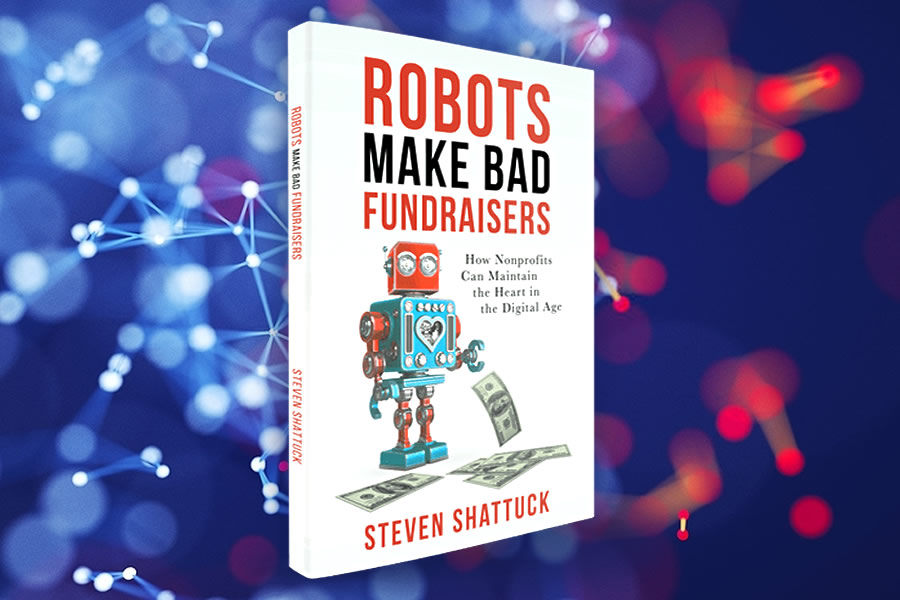
Robots Make Bad Fundraisers… at least, according to Steven Shattuck, Chief Engagement Officer at Bloomerang. And I agree with him.
In his debut book, Robots Make Bad Fundraisers: How Nonprofits Can Maintain the Heart in the Digital Age, Shattuck makes the case for personalization, individualization, and using technology appropriately.
Steven argues that nonprofit organizations have adopted automation to such an extreme degree that donor retention has suffered. And that’s a bad thing.
If for no other reason, you’ll want to read this book to learn “Why Retention Eats Acquisition for Breakfast,” the title of Chapter One. If you don’t know your donor retention rate or why it’s important, look no further than this book.
But let’s dive in a little deeper, because Shattuck’s new book is full of all kinds of wisdom.
Key Takeaways from ‘Robots Make Bad Fundraisers’
Here are five of key takeaways from Robots Make Bad Fundraisers that stood out.
1. Technology that doesn’t help you retain donors is harmful.
In making the argument for donor segmentation, Steven uses an analogy of sending the same birthday card to everyone on your list — your mom, your best friend, your sister, and your boyfriend. Clearly each one needs a distinct card and a personal message inside.
And, instead of sending the same email, newsletter, or appeal letter to first-time donors, long-time-donors, monthly donors, lapsed donors, and your largest donors, it’s important to have distinct messages for each group.
Not only that, you might have different messages for those who express an interest in your different programs. It makes no sense to speak about your nursery school to those who are most interested in your senior services.
2. Nonprofits are crummy at stewardship.
In a brilliant experiment, Shattuck gives to hundreds of random nonprofit organizations to assess their website, online giving page, and yes, their response to a first-time donor.
Without spoiling too much, I will tell you that in one of his experiments, zero organizations called to say thank you, despite 19 (out of roughly 50) requiring a phone number.
For years, I’ve been encouraging (begging) nonprofit leaders and fundraisers to make phone calls to thank donors. It will make you stand out and be unforgettable.
3. Do not use first names in email subject lines.
Shattuck says:
I’m guessing that out of all the individual emails you’ll send today, none of them will include the recipient’s first name in the subject line — unless you’re mad at the person you’re emailing.
In one case of how off-putting it is to use someone’s first name in the subject line, Shattuck provides a joke example: “Steven, singles in your area want to meet you! (They don’t.)”
Equally as offensive, “Steven, your donation is needed.” Shattuck ends by reminding us:
Just because we can do something, doesn’t mean we should.
4. All donor communication vehicles are better than Facebook (social media).
It’s time to go retro and communicate in more personal and meaningful ways. Call, write, email, survey, and meet your donors before trying to interact with them on social media (Facebook, specifically).
Don’t worry about being efficient. We’re not going for efficient. A personal touch is more effective. Period.
That said, Facebook might not be the monster it seems to be. I’ll let you read the book to learn how you can use Facebook as a force for good.
5. Make an online gift to your organization today.
This recommendation is one I make to every organization I work with.
If you haven’t already done so this year, go make an online donation to your organization… right now.
In other words, STOP what you’re doing (yes, stop reading this blog post). Go make the donation. It can be for as little as $1. Or spring for $5 per month. Then come back to this.
What was the experience like? Easy? Cumbersome? How were you thanked? The only way to know if there are flaws in the system is to test it yourself. Don’t blindly assume it works.
Here’s a personal example to drive this point home:
I recently consulted with a local affiliate of a national organization (I say that to demonstrate it was no rinky-dink nonprofit). At the beginning of the project, the first thing I did was try to make an online gift. Only I couldn’t. I wanted to give a monthly gift, but it wouldn’t allow me to do so with a credit card unless I had a PayPal account (which I don’t).
The organization’s leaders had no idea that donor couldn’t make a monthly donation with a credit card — because they had never tried!
So those are five reasons why robots make bad fundraisers. Don’t be a Robot.
And don’t just take my word for it. Go buy Steven’s new book and find out for yourself!
If you’ve read the book, or if you have some insight as to how an overreliance on technology and automation can adversely affect your fundraising, let me know in the comments. I’m eager to hear your thoughts.

Love this, good advice! just ordered the book!
Good tip to check out how your agency’s donation process works. Follow Amy’s advice and see what you find. You might have to update some materials.